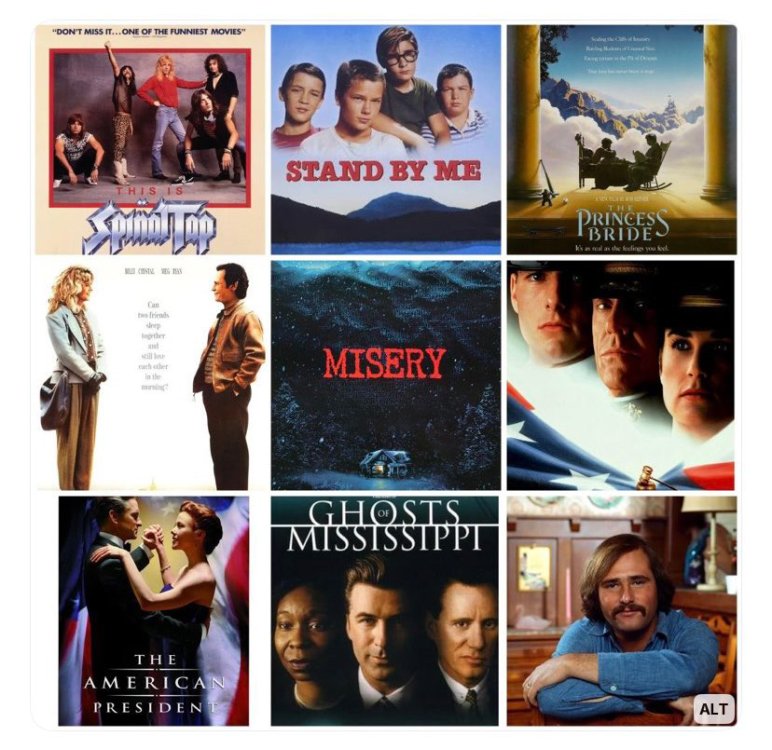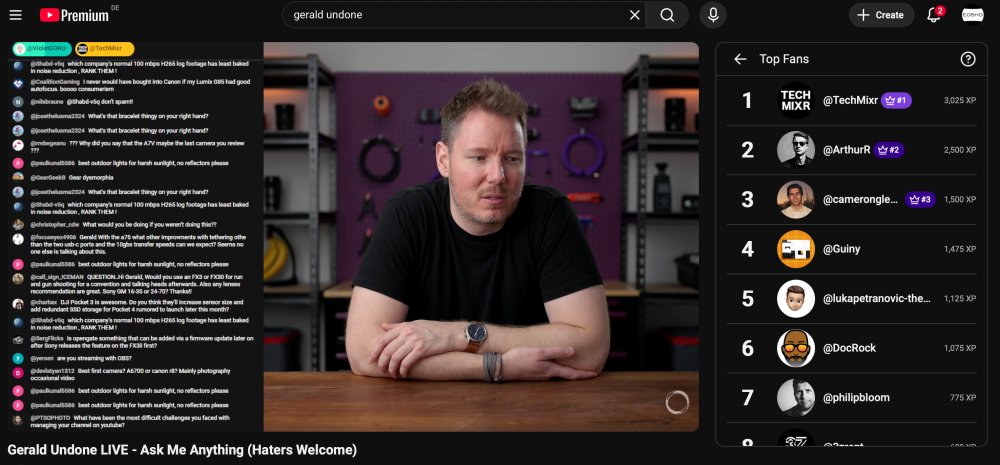-
Posts
15,626 -
Joined
-
Last visited
Content Type
Profiles
Forums
Articles
Everything posted by Andrew - EOSHD
-
I may do a comparison on the blog about the E-M1X and OM1. The E-M1X is... different.
-

Sigma Fp review and interview / Cinema DNG RAW
Andrew - EOSHD replied to Andrew - EOSHD's topic in Cameras
Any Sigma Fp-L owners about? It seems like a rare thing, the 60 megapixel pocket monster. One of the few cameras I refuse to part with though. -
It was a real low blow. Everyone has a big respect for Rob's achievement in filmmaking, the joy he brought to millions... Has the fucking penny dropped yet in the heads of these astonishing idiots who are in Trumps' fantasy land with him. It's a proper fucking cult. He has turned half of America into a right-wing cult. I don't know what's worse though... Is it the fantasy land of America-first narcissism or these kind of psychotic displays when someone dies... of him celebrating someone's death, throwing a pack of insults out to the family, at the time of the biggest tragedy of their lives, I can't even imagine what Rob's daughter is going through right now having found them all dead and then the media circus and that fucking cunt chiming in from his government hideout. He is simply incapable of forgetting or forgiving.
-
I've been enjoying his stories of the celebrity portrait shoots from the 90s and 2000s For a start the guy's work is fantastic, a great eye and a great instinct... superb really, and fascinating to hear his creative re-telling of the shoots. But in these videos he's also really candid about the stars, and their dreaded publicists / PR handlers A mixture of great... to really lacking respect for the photographer's art. The Paul McCartney one is pretty shocking but not as bad as Hilary Clinton 🙂 Love the PJ Harvey stuff though.
-
That's very true, they don't understand exactly what goes on in the neural networks. Then again I don't understand what goes on in the mind of other people, so that makes two of us
-
Dear @zlfan These posts are like spam. So I am going to put your account on pause while I look into whether you're a bot. Too many incidences of low quality posting recently and I have to make an editorial decision to protect the place, ok?
-
https://www.eoshd.com/news/thousands-of-sony-cameras-are-mysteriously-failing-but-sony-isnt-telling/
-
No more of this slop @zlfan, thanks
-
Sad news about Rob Reiner, and his wife, gifted photographer, Michele. The President says he died due to "Trump derangement syndrome" and the "anger he caused others". Writing in a social media post: "[Reiner] has passed away together with his wife, Michele, reportedly due to the anger he caused others through his massive, unyielding, and incurable affliction with a mind crippling disease known as Trump Derangement Syndrome". "He was known to have driven people CRAZY by his raging obsession of President Donald J Trump" Obviously, I find this troubling on so many levels. A real insight. That he can't even write RIP to one of Hollywood's greatest or send condolences to his family without making it all about himself and implying that Reiner had a mental illness. I think it's time for anyone who voted for him to take a bit of a step back from politics (if capable of that) to think about what they have done and who he is. And if after that you still can't bring yourself to snap out of the cult, but you still happen to be a forum member here I would like to ask you to leave. Hopefully you have already. In contrast here's how Ben Stiller remembers the Spinal Tap director, who like Rob had a comedian father... https://x.com/BenStiller/status/2000441874662961291 "He came out form behind a huge comedic shadow of the great Carl Reiner and being a tv actor to being a a great director who made an incredible run of movies. Spinal Tap is one of the best comedies ever made - and the list goes on. He was a kind caring person who was really really funny." Now there are reports coming from gossip outlets that Reiner and his wife were murdered by their son Nick who is now in police custody. What a shocking Hollywood tragedy and just an awful way for such great souls to go out, who have given us so much. Go and see Spinal Tap 2 everyone. RIP Rob & Michele Reiner.
-

Filming job in US? Delete your social media
Andrew - EOSHD replied to Andrew - EOSHD's topic in Cameras
Anyway I'm going to lock the thread, it's been completely wreaked as usual and it would be better to go back to cameras. -

Filming job in US? Delete your social media
Andrew - EOSHD replied to Andrew - EOSHD's topic in Cameras
I think praising someone that dangerous, with that kind of low moral standing, for being a good at executing a business plan is missing the point, but then each to their own. His PayPal chum is even worse. https://www.theguardian.com/us-news/2025/oct/10/peter-thiel-lectures-antichrist -

Filming job in US? Delete your social media
Andrew - EOSHD replied to Andrew - EOSHD's topic in Cameras
Easy to fall upwards when you have 498 billion in the bank! What with all that money his personal life is still a binfire. Only have to look at that to see the true character of the man. All the messy multiple affairs and abandoned sons, daughters. That's what he's singularly able to achieve merely as a man when he's not got the billionaire oligarch hat on. When he's got the billions and the companies he's able to take the credit for other people's hard work and that's how he built his entire reputation. -

Filming job in US? Delete your social media
Andrew - EOSHD replied to Andrew - EOSHD's topic in Cameras
-

Filming job in US? Delete your social media
Andrew - EOSHD replied to Andrew - EOSHD's topic in Cameras
Elon Musk did not invent SpaceX alone. He stood on: NASA contracts public research global supply chains skilled labor pools created by public education Not to mention striking it lucky with PayPal and the sellout to eBay for billions. -

Filming job in US? Delete your social media
Andrew - EOSHD replied to Andrew - EOSHD's topic in Cameras
I really don't think your hurt feelings should come into the conversation at all. They are not going to further the debate at all. "Feelings" are ironically why the world is in such a mess in the first place. If people listened and thought about reconsidering their misguided opinions when someone tells them the facts, the world would be a better place but instead they get all emotional, like a baby. -

Filming job in US? Delete your social media
Andrew - EOSHD replied to Andrew - EOSHD's topic in Cameras
To everyone I offended this year... work on yourself so I don't have to do it again next year. If after all you have seen, you still drink the Elon koolaid you deserve all the personal attacks coming to you. I have absolutely zero respect for your opinions or your feelings on the matter. It is entirely your responsibility that you feel insulted by what I said above even though it was objective fact and not at all personal. Elon is not a rocket scientist. He's a fucking twat face, alleged Nazi drug addict. I suppose you think his little fascist bromance with Trump was furthering the future of Planet Earth as well? -
I found out what he's been up to and it's the greatest irony in the history of the camera world. He has pivoted to cat videos. Very occasionally you will see a long review of a camera. This is his one on the Nikon Zr. I also tuned into another favourite of mine, Gerald Undone. He's done a Q&A where people throw money at him like a stripper. Except he's a bloke so can't tuck the money into his bra. I actually think this one of the purist examples of autism I have seen. And if we look at the top fans, Philip is 7th... I have no idea who the others are. TechMixr? That's quite a good question on the chat box... Which of the companies standard H.264/H.265 4K codecs at 100Mbit has the least noise reduction, aka most filimic, that I would like somebody to show. I can't be bothered and have sold all my gear to fund the forum hosting fees. Do you think the camera community would have worked out differently without all the narcissist Americans and Canadians? I think it would have. You'd have women in it for a start. Some real, talented actresses might be about... lending their opinions to DPs and gracing camera test scenes, instead we have some blokes being herded around like sheep by PR people from Sony and Panasonic! Maybe we'd have an alternative platform to YouTube... like the early days Vimeo with original file downloads, forums, and beautifully curated portfolios of work. Instead I do feel that the community has been rather sold out... And to an extent, those in it have sold yourselves out by being silly. You have worshipped at the feet of the social media influencer, lapped up the rumours site clickbait like gullible little fools, whittered on and on and on about what your camera strategy is for 2025, changing cameras like underpants, and dropping thousands on 8K RAW cinema cameras to shoot Instagram material with, delivered onto a 5 inch smartphone screen at 480p resolution in a 10 second endless loop.
-

Warner Bros - Netflix vs Trump and Larry Ellison
Andrew - EOSHD replied to Andrew - EOSHD's topic in Cameras
Some thoughts from film industry workers in Hollywood: https://www.bbc.com/news/articles/c8dyy47qy82o They can't decide whether a streaming company or right wing oligarch is the solution. I suppose it's a bit like trying to choose between Epstein and Jimmy Saville because the usual babysitter isn't available and the restaurant was booked in advance 3 weeks ago. You'll notice that not many of the people in the article still have a house. Even fewer want to be identified, presumably because they DO have a house and wish to keep it. Although I feel sorry for them, I am coming to terms with the thought that maybe a bit of a reset for cinema is what's needed. Not just because most of what's being made nowadays is complete shite anyway, but that theatre going can be removed, extracted, saved from the general public who have the combined IQ of 1000 PE teachers. Perhaps actual cinema-lovers can then go in peace to our smaller niche cinemas and watch actually good movies with emotional depth in them and substance. Leaving the Homer Simpsons of the world to stay on the sofa watching League of legends: the movie on their fucking phone with one hand and wanking to AI porn with the other. Wait. Did I just describe the average American?








